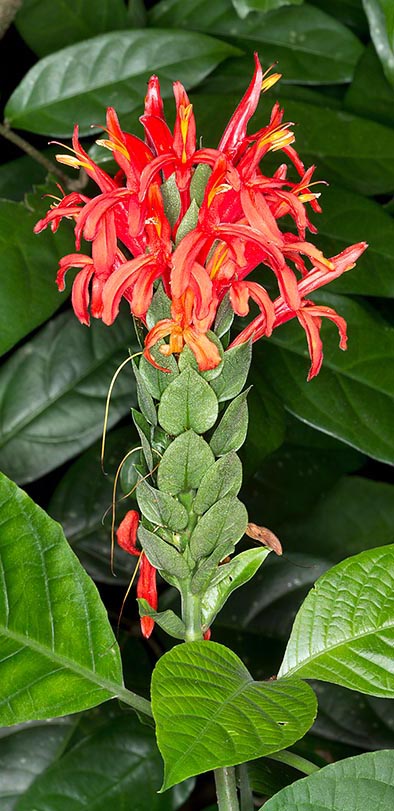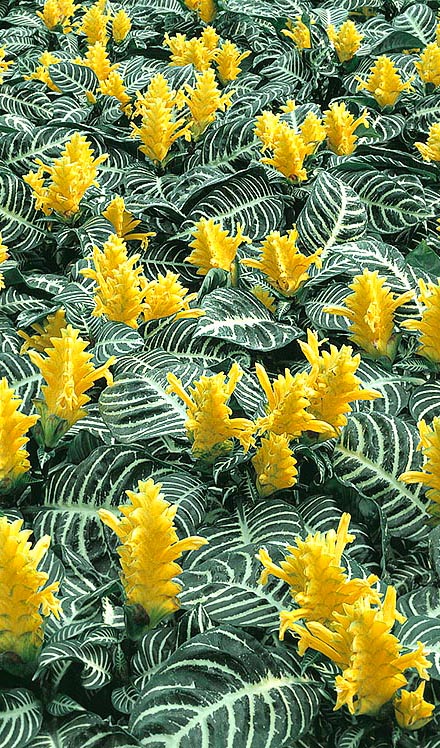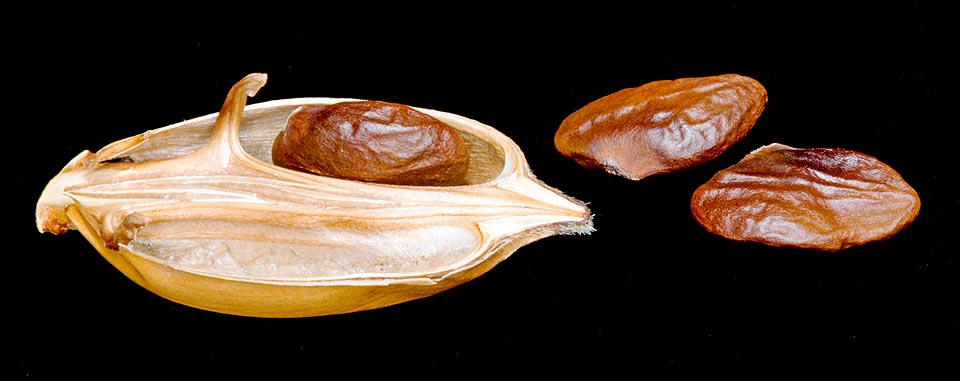
Text © Giuseppe Mazza

English translation by Ignacio Barrionuevo

Pachystachys coccinea © Giuseppe Mazza
Acanthaceae is a tropical family of flowering plants, with scarce representation in temperate climates.
It includes, above all, herbaceous and shrubby plants, although there also are some trees, lianas, semiaquatic species and xerophytes.
The best known species, which has given the name to the family, is Acanthus mollis, that inhabits Mediterranean Europe with its large pinnatipartite leaves that can be found as a decorative element in the Corinthian capitals of ancient Greece.
Their flowers, hermaphrodite, with more or less asymmetrical petals, are reunited almost always in inflorescences and often have showy petaloid bracts.
The typical architecture shows 5 (4) sepals and 5 (4) petals fused towards the base which form a cylindrical or infundibuliform corolla, 2 or 4 didynamous (two long and two short) fertile stamens sometimes flanked by infertile stamens, a long style with 2 stigmas and 2 fused carpels forming a bilocular superior ovary, having each one of the locules 2 or more ovules perpendicularly arranged to the funiculus, the stalk attaching the ovule to the flower’s placenta.
The latter, in addition to nourishing and sustaining the ovule, in Acanthaceae when maturity is reached, develops into a powerful spring that can throw in all directions the seeds, which usually have big embryos but they lack endosperm.
Pollination is mostly carried out by insects and birds, although in some species of Ruellia, Eranthemum, Blecchum, etc., the flowers show cleistogamy, remaining closed and auto-pollinating themselves.
Some species such as the Aphelandra squarrosa or the Crossandra nilotica are cultivated on a large scale worldwide as temporary ornamental plants for the house, but, in order to admire this family in all its splendour, one should visit the tropical gardens, although some exotic species, like Justicia brandegeeana, Ruttya fruticosa and the spectacular Thunbergia grandiflora grow relatively well in a temperate-warm climate’s open air.
There is no lack of medicinal plants in this family either, for instance Blechum pyramidatum and some species of Acanthus.
This family includes almost 4.000 species currently (2015) reunited in the following genera:

Aphelandra squarrosa © Giuseppe Mazza
Acanthopale, Acanthopsis, Acanthura, Acanthus, Achyrocalyx, Adhatoda, Afrofittonia, Ambongia, Ancistranthus, Ancistrostylis, Andrographis, Angkalanthus, Anisacanthus, Anisosepalum, Anisostachya, Anisotes, Anomacanthus, Apassalus, Aphanosperma, Aphelandra, Aphelandrella, Ascotheca, Asystasia, Asystasiella, Avicennia, Ballochia, Barleria, Barleriola, Beloperone, Benoicanthus, Blechum, Blepharis, Borneacanthus, Boutonia, Brachystephanus, Bravaisia, Brillantaisia, Brunoniella, Calacanthus, Calycacanthus, Camarotea, Carlowrightia, Celerina, Centrilla, Cephalacanthus, Chaetacanthus, Chalarothyrsus, Chamaeranthemum, Chileranthemum, Chlamydacanthus, Chlamydocardia, Chlamydostachya, Chorisochora, Chroesthes, Clarkeasia, Clinacanthus, Clistax, Codonacanthus, Conocalyx, Cosmianthemum, Crabbea, Crossandra, Crossandrella, Cuenotia, Cyclacanthus, Cynarospermum, Cyphacanthus, Cystacanthus, Danguya, Dasytropis, Dianthera, Dichazothece, Dicladanthera, Dicliptera, Dipteracanthus, Dischistocalyx, Dolichostachys, Duosperma, Dyschoriste, Ecbolium, Echinacanthus, Elytraria, Encephalosphaera, Epiclastopelma, Eranthemum, Eremomastax, Eusiphon, Filetia, Fittonia, Forcipella, Geissomeria, Glossochilus, Graphandra, Graptophyllum, Gymnophragma, Gymnostachyum, Gynocraterium, Gypsacanthus, Habracanthus, Hansteinia, Harpochilus, Haselhoffia, Hemiadelphis, Hemigraphis, Henrya, Herpetacanthus, Heteradelphia, Himantochilus, Holographis, Hoverdenia, Hygrophila, Hymenochlaena, Hypoestes, Ionacanthus, Isoglossa, Isotheca, Ixtlania, Jacobinia, Jadunia, Justicia, Kalbreyeriella, Kosmosiphon, Kudoacanthus, Lankesteria, Lasiocladus, Leandriella, Lepidagathis, Leptostachya, Liberatia, Lissospermum, Listrobanthes, Lophostachys, Louteridium, Lychniothyrsus, Mackaya, Mananthes, Megalochlamys, Megalostoma, Megaskepasma, Melittacanthus, Mellera, Mendoncia, Metarungia, Mexacanthus, Microstrobilus, Mimulopsis, Mirandea, Monechma, Monothecium, Nelsonia, Neriacanthus, Neuracanthus, Nilgirianthus, Nothoruellia, Odontonema, Ophiorrhiziphyllon, Oplonia, Orophochilus, Pachystachys, Pachystrobilus, Paragutzlaffia, Pararuellia, Parastrobilanthes, Pericalypta, Periestes, Peristrophe, Petalidium, Phaulopsis, Phlogacanthus, Physacanthus, Pleocaulus, Podorungia, Poikilacanthus, Polylychnis, Populina, Pranceacanthus, Psacadopaepale, Pseuderanthemum, Pseudocalyx, Pseudodicliptera, Pseudoruellia, Pseudostenosiphonium, Psilanthele, Pteracanthus, Pteroptychia, Ptyssiglottis, Pulchranthus, Pupilla, Razisea, Rhacodiscus, Rhinacanthus, Rhytiglossa, Ritonia, Ruellia, Ruelliopsis, Rungia, Ruspolia, Ruttya, Saintpauliopsis, Sanchezia, Sarojusticia, Sarotheca, Satanocrater, Schaueria, Sclerochiton, Semnothyrsus, Sericocalyx, Sericographis, Siphonoglossa, Spathacanthus, Sphacanthus, Staurogyne, Staurogynopsis, Stenandriopsis, Stenandrium, Stenostephanus, Streblacanthus, Streptosiphon, Strobilanthes, Strobilanthopsis, Suessenguthia, Symplectochilus, Synnema, Taeniandra, Teliostachya, Tessmanniacanthus, Tetraglochidium, Tetramerium, Thelepaepale, Thunbergia, Thyrsacanthus, Trichanthera, Trichaulax, Trichosanchezia, Vavara, Vindasia, Whitfieldia, Xantheranthemum, Xanthostachya, Xenacanthus, Yeatesia, Zygoruellia.

Open Acanthus mollis fruit with seeds. Both funiculi can be seen developed into springs that have expelled the seeds 5 m away © Giuseppe Mazza
→ To appreciate the biodiversity within the family ACANTHACEAE please click here.
